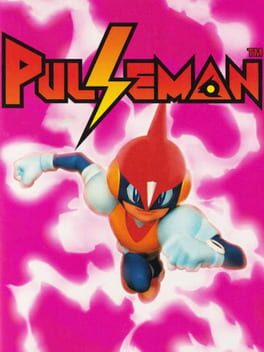▲
1
▼
 In the game's opening cutscene after Dr. Yoshiyama digitizes himself, several blocks of what seems to be gibberish appear on-screen before the computer corrupts. This gibberish is actually a secret message written in Japanese romaji and then coded through a cipher where all vowels are omitted from the text, except for when a word starts with a vowel. Decoding the message reveals what seems to be the last conversation Yoshiyama had with the C-Life woman featured in the cutscene, the mother of Pulseman, suggesting that he gave up his human life ("Do you realize what you've done? You'll never be human again now.") out of love for his creation and resulting in the conception of Pulseman. A cosmetic detail hinting at the nature of the undeciphered message being a conversation are differences in the speed at which each text box appears typed out on-screen (i.e. a slight slowdown during "I'm just a heartless program"). However, not only does this affair reveal the origin of the game's hero, it also has implications about the origin of the game's villain.
In the game's opening cutscene after Dr. Yoshiyama digitizes himself, several blocks of what seems to be gibberish appear on-screen before the computer corrupts. This gibberish is actually a secret message written in Japanese romaji and then coded through a cipher where all vowels are omitted from the text, except for when a word starts with a vowel. Decoding the message reveals what seems to be the last conversation Yoshiyama had with the C-Life woman featured in the cutscene, the mother of Pulseman, suggesting that he gave up his human life ("Do you realize what you've done? You'll never be human again now.") out of love for his creation and resulting in the conception of Pulseman. A cosmetic detail hinting at the nature of the undeciphered message being a conversation are differences in the speed at which each text box appears typed out on-screen (i.e. a slight slowdown during "I'm just a heartless program"). However, not only does this affair reveal the origin of the game's hero, it also has implications about the origin of the game's villain.Dr. Yoshiyama's whereabouts during the events of Pulseman are never stated, but through information provided in the game's manual, it is suggested that he was corrupted during his time in cyberspace and transformed into the game's antagonist Dr. Waruyama. This theory is supported by the manual listing Yoshiyama's entry into cyberspace during the cutscene and Waruyama's birthdate, December 31, 1999, as occurring in the same year. However, Waruyama appears to be a full-grown adult by 2015 when the main events of the game take place despite technically being 16 years old and less than two years older than Pulseman.
This age discrepancy suggests that Waruyama would have to be at least a half C-Life or full C-Life himself in order for him to originally have been "born" as an adult (given that C-Lifes are computer-generated life-forms), and in this case, for him to originally have been the adult Yoshiyama. Since Yoshiyama was implied to have transformed into at least a half C-Life following the deciphered conversation, this suggests that Waruyama's "birthdate" actually refers to the exact date when Yoshiyama was transformed into Waruyama in the first place.
Additionally, there are similarities between the two names, with "Waruyama" being similar to "Bad mountain" ("悪い山" or "Warui yama"), and "Yoshiyama" appearing similar to "Pleasant mountain" ("楽しい山" or "Tanoshī yama").
The English description for the game's 2009 re-release on the Wii Virtual Console states outright that Yoshiyama did transform into Waruyama, although there are no known Japanese sources that also confirm this.
Pulseman message deciphered:
https://www.youtube.com/watch?v=Jn7ZdDsD5p8
Pulseman manual:
https://segaretro.org/images/6/65/Pulseman_md_jp_manual.pdf
IGN review of the game's Wii Virtual Console release:
https://www.ign.com/articles/2009/07/23/pulseman-review
https://www.youtube.com/watch?v=Jn7ZdDsD5p8
Pulseman manual:
https://segaretro.org/images/6/65/Pulseman_md_jp_manual.pdf
IGN review of the game's Wii Virtual Console release:
https://www.ign.com/articles/2009/07/23/pulseman-review
▲
1
▼
In the early stages of development, Pulseman was originally meant to play similarly to Magical Taluluto (based on the Shonen Jump manga of the same name), the first game directed by Ken Sugimori who was also the director for Pulseman.
For example, he originally had the ability to turn into a fighter jet and fly by pressing the jump button twice, but this was scrapped, as it didn’t fit his character.
For example, he originally had the ability to turn into a fighter jet and fly by pressing the jump button twice, but this was scrapped, as it didn’t fit his character.
▲
1
▼
Pulseman’s Japanese anime-inspired design was made as a direct opposition to Sonic The Hedgehog's design, as Sonic was popular in the ‘90s and had a Western cartoon look to it. He was also made red to be opposite to Sonic's blue.
Related Games
Sonic Frontiers
Pokémon Emerald Version
Super Monkey Ball Adventure
Sonic & Sega All-Stars Racing
Alien: Isolation
Alien Soldier
Sonic Adventure 2: Battle
Sonic & All-Stars Racing Transformed
Yakuza
Sonic the Hedgehog Genesis
Bushi Seiryuu-den: Futari no Yuusha
Crazy Taxi
Pokémon X
Maimai DX Splash
Maimai DX Universe
Sakura Wars
Panzer Dragoon Saga
Etrian Mystery Dungeon
Pokémon Alpha Sapphire
Pokémon Diamond Version
Dynamite Headdy
Sonic Heroes
Pokémon Moon
Pokémon Black Version 2
Virtua Fighter 3
Ristar
Sonic Gems Collection
Mario & Sonic at the Olympic Games Tokyo 2020
Mario & Sonic at the Olympic Winter Games
Maimai DX Splash Plus
The Revenge of Shinobi
Golden Axe
Pokémon Gold Version
Sonic & All-Stars Racing Transformed
Virtua Fighter 3tb
Puyo Puyo 2
Chakan: The Forever Man
Doom
ToeJam & Earl
Sonic X-treme
Sonic & Sega All-Stars Racing
Valkyria Chronicles
Enemy Zero
Metaphor: ReFantazio
Pocket Card Jockey
Pokémon Omega Ruby
Castle of Illusion Starring Mickey Mouse
Gunstar Heroes
Sonic Superstars
Virtua Fighter
